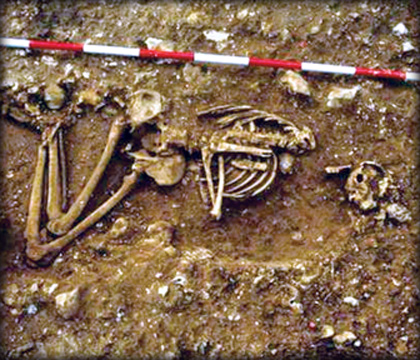|
Racton Man:
Analysis shows famous skeleton was a 6ft Bronze Age superman
A quarter of a century after his skeleton was unearthed in a Sussex
field,
"Racton Man" has finally revealed his secrets. And it turns out he
was quite the Bronze Age hero.
Scientific analysis of his bones has revealed he was probably a
tribal leader with a giant stature - and may have been killed in combat.
|

The skeleton was found on farmland in the hamlet of Racton,
near Chichester in West Sussex, in 1989 |
Not only did he tower over his fellow men, coming in at 6ft tall, but
he also outlived most of them by a considerable margin, managing to
survive for at least 45 years before finally meeting his death through a
sword slash near his elbow.
His weapon of choice was also remarkable - a bronze dagger that, at
4,200 years of age, represented the ultimate cutting-edge technology and
is the earliest bronze object to have been found in Britain, researchers
said.
"The fact that this man had a bronze dagger would have been
incredibly rare then. This would have been right at the start of the
introduction of this type of technology," said James Kenny, the
Chichester council archaeologist who discovered the skeleton in the West
Sussex hamlet of Racton back in1989.
"He would have been a very prominent member of society, someone of
great seniority," said Dr Stuart Needham, a Bronze Age specialist who
also worked on the project, adding that his social position may well
have depended on his demonstrating his prowess in combat.
The blade of the dagger, with its rivet-studded handle, was
repeatedly sharpened, the researchers said.
The dagger was made at the dawn of bronze-working techniques, when
metal-smiths in Britain learnt from the Continent how to mix their
copper with West Country tin and make a far harder and more beautiful
alloy.
Despite being uncharacteristically strong, there are signs that
Racton Man's tough life was catching up with him by the end. Analysis of
his bones revealed signs of spinal degeneration, which are thought to be
age-related, while he was also suffering from a chronic sinus infection
and arthritis. A severe cut has been found - "at or near the time of
death" - to the upper-right arm bone, close to the elbow, and there is
no sign that this had healed.
This is consistent with the arm being raised, elbow bent above the
head, to protect it from a blow from a weapon.
Racton Man is thought to have died between 2300BC and 2150BC. "To
think we can discover such detail about a man who died more than 4,000
years ago, while learning more about the country's history, is just
incredible," said Myles Cullen of Chichester District Council.
Kenny said the long wait to discover Racton Man's identity was down
to a lack of funding. Back in the 1980s, techniques such as carbon
dating were much more expensive and less effective than they are today.
As a result, the skeleton languished in the Novium Museum storage
facility in Chichester for years. Kenny had all but forgotten about the
skeleton when he mentioned it two years ago to Dr Needham. The pair went
to look at the skeleton and dagger in the museum store.
They secured funding from the South Downs National Park and the local
council and assembled a team of experts to carry out the research. The
skeleton and dagger are now on display at the museum.
- The Independent
|

